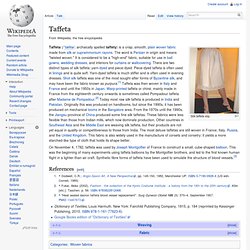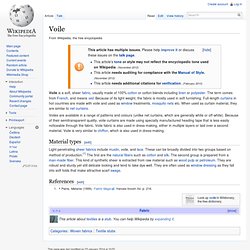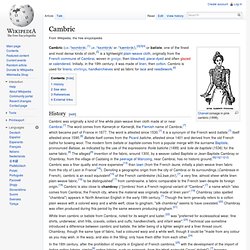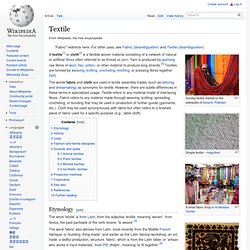

Organdy. Taffeta. Silk taffeta slip.

On November 4, 1782, taffeta was used by Joseph Montgolfier of France to construct a small, cube-shaped balloon. This was the beginning of many experiments using taffeta balloons by the Montgolfier brothers, and led to the first known human flight in a lighter-than-air craft. Synthetic fibre forms of taffeta have been used to simulate the structure of blood vessels.[3] Voile. Voile is a soft, sheer fabric, usually made of 100% cotton or cotton blends including linen or polyester.

The term comes from French, and means veil. Because of its light weight, the fabric is mostly used in soft furnishing. Full-length curtains in hot countries are made with voile and used as window treatments, mosquito nets etc. When used as curtain material, they are similar to net curtains. Material types[edit] Lawn cloth. Characteristics[edit] History[edit] The term "lawn" derives from "Laon", a city in France, which produced large quantities of linen lawn.

Uses[edit] It is also commonly used in liturgical vestments in the Anglican churches, such as the surplice and episcopal rochet: "No— it was not for love of lucre that he wished to be bishop of Barchester. ...But he certainly did desire to play first fiddle; he did desire to sit in full lawn sleeves amongst the peers of the realm; and he did desire, if the truth must be out, to be called 'My Lord' by the reverend brethren Notes[edit] See also[edit] Velvet. A swatch of velvet Yellow velvet Velvet ciselé, red ornament The word 'velvety' is used as an adjective to mean "smooth like velvet.

" Velvet can be either synthetic or natural. Composition[edit] Velvet can be made from many different kinds of fibers, traditionally silk. Cambric. Charvet corsage in pink cambric (1898).

History[edit] Brocade. Lace-Patterned silk brocade, Russia, early 18th century Large brocade loom, Nanjing, China, 2010 Persian Silk Brocade, Brocade weaver: Master Seyyed Hossein Mozhgani. 1974 A.D. the Ministry of Culture and Art .

Honarhaye Ziba workshop. In Guatemala, brocade is the most popular technique used to decorate fabric woven by Maya weavers on backstrap looms. Ornamental features in brocade are emphasized and wrought as additions to the main fabric, sometimes stiffening it, though more frequently producing on its face the effect of low relief. Textile. Mrs.

Condé Nast wearing one of the famous Fortuny tea gowns. This one has no tunic but is finely pleated, in the Fortuny manner, and falls in long lines, closely following the figure, to the floor. The words fabric and cloth are used in textile assembly trades (such as tailoring and dressmaking) as synonyms for textile. However, there are subtle differences in these terms in specialized usage. Textile refers to any material made of interlacing fibres. Etymology[edit] The word 'textile' is from Latin, from the adjective textilis, meaning 'woven', from textus, the past participle of the verb texere, 'to weave'.[4] The word 'fabric' also derives from Latin, most recently from the Middle French fabrique, or 'building, thing made', and earlier as the Latin fabrica 'workshop; an art, trade; a skillful production, structure, fabric', which is from the Latin faber, or 'artisan who works in hard materials', from PIE dhabh-, meaning 'to fit together'.[5]
Natural Fabrics. Natural fabrics are those which are created from the fibers of animals coats, the cocoons of silkworms, and plants seeds, leaves and stems. It is breathable and never cause rashes apart from being soft and durable. Natural fabric is the best choice for everyone. It does not change color from UV light and there is no warming until the material looses its tensile strength. Common Natural Fabrics - It is versatile with natural comfort and durability. . - If we talk about silk, we talk about softness, beauty and luxuriousness. . - Wool means warmth, softness and strength. . - The fabric which never ages. . - The warmth, softness and durability of hemp fabric is rarely found in any other fabric. . - It is known for its resilience and durable quality. . - It is eco-friendly with good strength and durability.